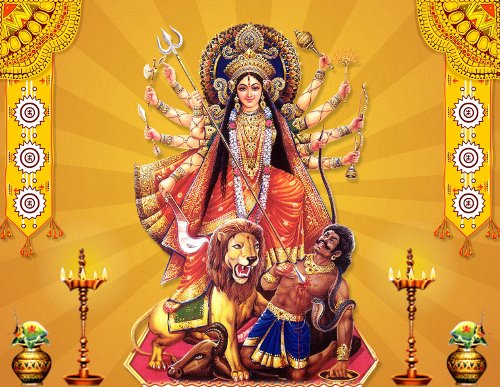Ayuta Chandi Mahayaga

Goddess Durga – Divine mother of all creation
Every person in this world desires for ever-lasting happiness sans misery. The Shastras proclaim that such happiness can be begotten by worship of the Divine Godhead. In reality Omnipotent all pervading God is formless and devoid of any physical or describable characteristics. Through his all pervading Maya Shakti, that Omniscient One Godhead assumes multifarious forms of Ganapati, Shiva, Vishnu, Devi and other divine forms for the purpose of blessing devotees. The devotees worship that One All-pervading Brahman in one of the myriad forms of their choice.
Mother has a special place in our hoary tradition of Sanatana Dharma. The Vedas Proclaim
मातृ देवो भव
or perceive one’s mother as God. Thus, by propitiating Devi, the mother of all creation we can overcome all misery and derive happiness. Puja, Japa, Parayana, Homa etc. are aspects of worshipping the Divine mother. The greatness of the Divine mother has been extolled in the Devi Bhagavata, Brahmanda Purana, Skanda Mahapurana, Mahabharata and other scriptures. However the Durga-Saptashati or Devi-Mahatmya occuring in the Markandeya Purana is of paramount importance. The greatness of this text, Sri Durga Saptashati as occuring in the Markandeya Purana has been extolled in Damara Tantra and other tantrik texts. By the parayana of this sacred text, difficulties are over come, diseases are cured and wishes fulfilled.
The Durga Saptashati is comprised of three Charitras, namely Prathama, Madhyama and Uttama in thirteen chapters. The Prathama Charitra describes the glories of the Divine mother as revealed by a Rishi to a Vaishya and Raja Suratha who prayed to the Rishi to alleviate his problems while roaming about the forest after being abandoned by his kith and kin. In the second charitra, the Avatara of Goddess Mahalakshmi, the slaying of Mahishasura along with his entire army of warriors, Eulogy of the Divine mother by the Gods, and granting of boons to Indra and other Gods by the Divine Mother have been described vividly. The third charitra describes the slaying of Chanda-Munda and other demons by the Divine mother through her Fiery eye as an answer to the prayer by the Gods who were aggrieved by the pains inflicted by Shumba and other wicked demons, the Avatara of Brahmi, Maheshwari and other divine goddesses from the body of the Divine Mother, the slaying of Raktabija, Nishumbha and Shumba by the Divine Mother, Eulogy of the Divine Mother by the Gods and her granting wishes to them, worship of the Divine Mother by Suratha and Samadhi, and vision of the pleased Divine mother granted to them, granting of Kingdom to King Suratha and Divine knowledge to the Vaishya. The Shastras have prescribed parayana of this Durga Saptashati one, ten, hundred or thousand times known as Chandi, Nava-Chandi, Shata Chandi and Sahasra Chandi respectively for the fulfilment of various wishes.
In Sanskrit, “शं” means good or auspicious and “कर” means doer. The Gurus of the Sringeri Sharada Peetham in the hoary lineage of Jagadguru Sri Adi Shankacharya who established the Sharada Peetham at Sringeri with the sole objective of welfare to one and all, are all “Shankaras” by themselves. It is thus that our Jagadguru Sri Sri Bharati Tirtha Mahaswamiji, has resolved for an Ayuta Chandi Mahayaga to be conducted by the Math for the welfare of the world. Ayuta means ten thousand in Sanskrit. In this great Yajna, that is being conducted perhaps for the first time in the known History of Sringeri or even South India, over one thousand Ritwijas will take part and perform a total of ten thousand parayanas of Durga Saptashati, one crore japas of Chandi-Navakshari Mantra throughout the five days. Kalpokta Avarana Puja, will be performed by the Pradhana-Acharya to the newly made murti and yantra of Sri Chandika Parameshwari as a part of Purashcharana. Sahasranamarchana, Mahamangalarati and Ashtavadhana Seva and other ceremonies will be performed in the evening throughout the five days. In accordance with the scriptural dictum –
प्रति श्लोकं च जुहुयात् पायसं च सर्पिषा
oblations of Payasa will be offered by the thousand officiating priests in one hundred Homa-Kundas blazing with the sacrificial fire on the final sixth day. The entire Yaga comes to the grand finale of the Purnahuti ceremony conducted by the Pradhana-Acharya or the chief officiating priest in the august presence of the Jagadguru Shankaracharya, on completion of the aforementioned Homa.
The following translations of this articles are available.
